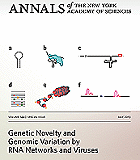 leaf tisue. copyright Panthermedia.
My research interests are biocommunication processes and natural genome editing.
leaf tisue. copyright Panthermedia.
My research interests are biocommunication processes and natural genome editing.
This means that:

cells, tissues, organs and organisms coordinate and organize by communication

processes, i.e. sign.mediated interactions

nucleotide sequence order and the ratio of genome architecture are structured

language-like, i.e. follow combinatorial (syntactic), context-sensitive (pragmatic)

and content-specific (semantic) rules
My investigations therefore focus on

sign-mediated interactions within and between all kind of cellular organisms

(archaea, bacteria, eukarya)

the role of persistent viruses and subviral agents in replication, transcription,

translation, repair and recombination

persistent viral agents and the evolution of their persistence

applied linguistic competences of natural genetic engineers

the role of viruses in the evolution of tissues and organs

the role of subviral RNAs in the generation of viral identities

communal and cooperative evolutionary processes

natural invention and integration of novel nucleitide sequences

Multiply (re)usable nucleotide sequence contents and regulatory agents

immunity: pragmatic conditions, syntactic sequence order, semantic content flow

 cells, tissues, organs and organisms coordinate and organize by communication
cells, tissues, organs and organisms coordinate and organize by communication
 processes, i.e. sign.mediated interactions
processes, i.e. sign.mediated interactions nucleotide sequence order and the ratio of genome architecture are structured
nucleotide sequence order and the ratio of genome architecture are structured
 language-like, i.e. follow combinatorial (syntactic), context-sensitive (pragmatic)
language-like, i.e. follow combinatorial (syntactic), context-sensitive (pragmatic) and content-specific (semantic) rules
and content-specific (semantic) rules sign-mediated interactions within and between all kind of cellular organisms
sign-mediated interactions within and between all kind of cellular organisms (archaea, bacteria, eukarya)
(archaea, bacteria, eukarya) the role of persistent viruses and subviral agents in replication, transcription,
the role of persistent viruses and subviral agents in replication, transcription, translation, repair and recombination
translation, repair and recombination persistent viral agents and the evolution of their persistence
persistent viral agents and the evolution of their persistence applied linguistic competences of natural genetic engineers
applied linguistic competences of natural genetic engineers the role of viruses in the evolution of tissues and organs
the role of viruses in the evolution of tissues and organs the role of subviral RNAs in the generation of viral identities
the role of subviral RNAs in the generation of viral identities communal and cooperative evolutionary processes
communal and cooperative evolutionary processes natural invention and integration of novel nucleitide sequences
natural invention and integration of novel nucleitide sequences Multiply (re)usable nucleotide sequence contents and regulatory agents
Multiply (re)usable nucleotide sequence contents and regulatory agents immunity: pragmatic conditions, syntactic sequence order, semantic content flow
immunity: pragmatic conditions, syntactic sequence order, semantic content flow

 Phages represent the most diverse inhabitants on this planet. Until today they are completely underestimated in their number, skills and competences and still remain the dark matter of biology
Phages represent the most diverse inhabitants on this planet. Until today they are completely underestimated in their number, skills and competences and still remain the dark matter of biology Genetic Novelty / Genomic Variations by RNA Networks and Viruses
Genetic Novelty / Genomic Variations by RNA Networks and Viruses
 Memory and Learning in Plants
Memory and Learning in Plants
 Biocommunication of Ciliates
Biocommunication of Ciliates Biocommunication of Animals
Biocommunication of Animals
 Biocommunication of Fungi
Biocommunication of Fungi Viruses - Essential Agents of Life
Viruses - Essential Agents of Life "Plants assess their surroundings, estimate how much energy they need for particular goals, and then realise the optimum variant. They take measures to control certain environmental resources. They perceive themselves and can distinguish between ‘self ’ and ‘non-self ’."
"Plants assess their surroundings, estimate how much energy they need for particular goals, and then realise the optimum variant. They take measures to control certain environmental resources. They perceive themselves and can distinguish between ‘self ’ and ‘non-self ’." 


